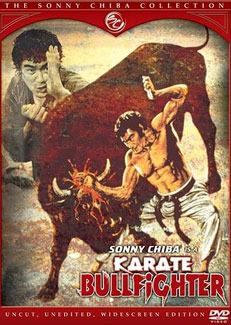 First of a trilogy based rather preposterously on the life of the founder of the Kyokushin school of karate, master Sosai Masutatsu Oyama, Karate Bullfighter aka Champion of Death (Kenka karate kyokushin-ken, 1975) stars Shinichi "Sonny" Chiba as Mas Oyama. Mas was Chiba's actual karate mentor, around whom more myth than biography was gathered for these films. First of a trilogy based rather preposterously on the life of the founder of the Kyokushin school of karate, master Sosai Masutatsu Oyama, Karate Bullfighter aka Champion of Death (Kenka karate kyokushin-ken, 1975) stars Shinichi "Sonny" Chiba as Mas Oyama. Mas was Chiba's actual karate mentor, around whom more myth than biography was gathered for these films.
Chances are, Mas Oyama's actual life would have made an okay film, but authentic biography in no way intrudes on this little number. Since Mas himself was still alive & well in the '70s, & was even an consultant on the film cycle, presumedly he didn't mind being portrayed as a crazed wildman & even as a rapist.
It is 1949. After his exerpiences in the war, followed by a period of seclusion in the mountains, Mas Oyama comes down from his retreat & bursts onto the karate scene like a huricane. He attends the first Japanese karate championship since the end of the Pacific War, & he truly kicks butt.
After winning the tournament, Mas rejects the spotlight of the karate community, & becomes a riksha driver. It is harder to put his success behind him than he may have imagined. Ariake (Jiro Chiba) pesters Mas to become his sensei, & against his better judgement Mas begins training him. He afterward feels responsible for having made a psychopath invincible & must personally do something about the repurcussions.
Meanwhile, a sleek, appealing, almost gentlemanly karate master (Mikio Narita) feels that the respectability of karate will be diminished if street-tough fighters like Mas & all who would emulate him drag karate into the gutters. His noble sentiments somehow lead him to the conclusion that Mas has to be assassinated, but fat chance.
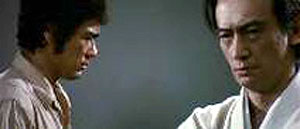 The central image of the film occurs when a rampaging bull threatens a village, & Mas Oyama, Hercules-like, is able to defeat the beast with his karate skills. The central image of the film occurs when a rampaging bull threatens a village, & Mas Oyama, Hercules-like, is able to defeat the beast with his karate skills.
This is cool crap, as long as one doesn't take too seriously the bull's blood on Shinichi Chiba's face during faked cruelty to an animal. This event of course never happened, but Mas did in fact claim that in his early training, he would visit a nearby slaugherhouse & kill cattle with karate blows to their foreheads. It was for this claim he gained the title "Mas the Bullfighter" which in turn inspired the fictional script.
The plot is hurky-jerky & unimportant. Many scenes would stand alone or could be rearranged in almost any order. The nonstop trashy action of Karate Bullfighter is hokum of course, but Chiba is so intent & intense that he's great fun to see in physical motion.
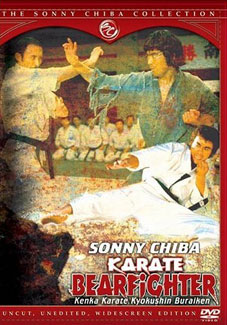 Chiba again plays Mas Oyama in Karate Bear Fighter (Kenka karate kyokushin buraiken, 1975). Mas has a cameo appearance during the opening credits, & again gave his stamp of approval to this phonied up biography. Chiba again plays Mas Oyama in Karate Bear Fighter (Kenka karate kyokushin buraiken, 1975). Mas has a cameo appearance during the opening credits, & again gave his stamp of approval to this phonied up biography.
The first film having trumped up an explanation for Mas's knickname "the bullfighter" left the creative team eager to repeat this animal-fighting image.
With a flimsy excuse, Mas has a karate match with a bear. It's staged & edited to look about fifty percent real &ajmp a hundred percent silly, & like the film in general is not as well done as the bull encounter in the first film.
Yakuza in cartoony versions of western mafia suits & sunglasses are glad to have Mas as a bodyguard, but he's dissatisfied with the direction his life had taken, as his karate goals originated as a spiritual journey.
There is even less of a story than in the first film. There is no flow to the action nor inevitability to the order of events, & there are fewer side-characters of any interest. Even so, scene for scene, the action set-ups can be entertaining.
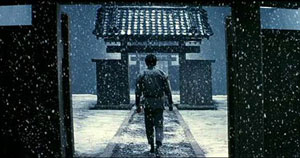 Despite a streak of kindness & a desire to upraise rather than muddy karate, Mas is in the main portrayed as a madman, which suits Shinichi Chiba's physical acting style Despite a streak of kindness & a desire to upraise rather than muddy karate, Mas is in the main portrayed as a madman, which suits Shinichi Chiba's physical acting style
Because Mas has encountered rejection from the old guard of the karate community, he goes from dojo to dojo proving he's tougher than any school's best students & teachers. This gets him enemies he doesn't need.
Karate Bear Fighter is less sequel than semi-remake of Karate Bullfighter, so delivers only the most predictable content. Anyone who admires Japanese cinema because it is capable of being violent & yet tell a really great story will not be impressed by the Mas Oyama trilogy which is brutal with scarsely any context beyond "it's exploitaiton cinema, what did you expect?" But devotees of emptyheaded actioners will have exactly what they're after.
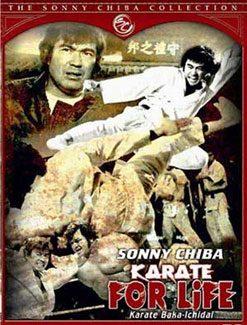 Shinichi Chiba reprises his role as Masutatsu Oyama for the third & last time in Karate for Life aka The Fanatical Karate Generation (Karate baka-ichidai, 1977), set in post-war occupied Okinawa, circa 1952.
Shinichi Chiba reprises his role as Masutatsu Oyama for the third & last time in Karate for Life aka The Fanatical Karate Generation (Karate baka-ichidai, 1977), set in post-war occupied Okinawa, circa 1952.
Oyama tumbles about town working as a nightclub bouncer for the yakuza, & during the day visits karate dojos to challenge each school's best fighters. He can find no one who is his equal.
Because of Mas's open-hand fights with a bear & with a raging bull, he is ejected from the Japan Karate Society for inappropriate behavior. But this same misbehavior has made him famous all over Japan.
A wrestling promoter offers to make him a wrestling star, which appeals to his ego. Karate vs Wrestling (with even a couple of western wrestlers as opponents) isn't actually a lot to be egotistical about, since a trained karateka would seem a cinch to outmatch fat, slow, circusy wrestlers.
This means the fights outside the ring are more interesting than the scenes pitting Chiba against actual wrestling champs, because any combat involving actual stuntmen or members of Chiba's own Japan Action Club is inevitably more athletic, even if it is all ultimately just one big circus.
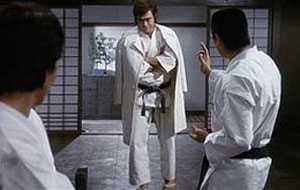 Mas was naive enough to believe the matches were always to be on the level. When he discovers the fights are controlled by yakuza who expect him to win or lose according to their needs, he rebels, making enemies of Okinawa yakuza, & can no longer get work. Mas was naive enough to believe the matches were always to be on the level. When he discovers the fights are controlled by yakuza who expect him to win or lose according to their needs, he rebels, making enemies of Okinawa yakuza, & can no longer get work.
After talking a beautiful young woman out of suicide, Oyama becomes her platonic protector. When she becomes ill & needs medicine that is hard to come by during the Occupation, it looks like his only way of raising money will be to buckle to the will of the yakuza.
Make no mistake, this is trash cinema, but it would be hard to expose oneself to karate films & not already expect trash. Given that very few Americans know what polite Japanese really think of Americans, it may be an eye-opener to see Occupation soldiers stereotyped as sadistic rapists. Also because Chiba was still trying too hard to be the new Bruce Lee, there's a long scene in a house of mirrors straight out of Enter the Dragon (1973), so pretty hard to see this as anything more than repetitious nonsense.
Striving to outdo the action content of the previous two installments, Karate for Life pits Mas against one hundred & one opponents at once. This is borrowed in part from Bruce Lee's Fists of Fury (1971), but whereas bodies don't much accumulate or get in the way in Fists of Fury, by the time Mas Oyama is finished with his one-against-all encounter, he's walking on bodies. This isn't supposed to be funny but it is; & it was supposed to be funny when done similarly in the short Bruce Lee spoof "A Fistful of Yen" that became the centerpiece of Kentucky Fried Movie (1977).
Chiba is still pretty young & in great physical shape & makes the most out of the exciting choreography. If fast-moving karate entertainment sounds appealling, Karate for Life delivers nothing less & certainly nothing more.
See also Chiba's
Streetfighter Series
copyright © by Paghat the Ratgirl
|
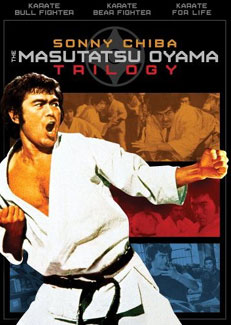

 The central image of the film occurs when a rampaging bull threatens a village, & Mas Oyama, Hercules-like, is able to defeat the beast with his karate skills.
The central image of the film occurs when a rampaging bull threatens a village, & Mas Oyama, Hercules-like, is able to defeat the beast with his karate skills.
 Despite a streak of kindness & a desire to upraise rather than muddy karate, Mas is in the main portrayed as a madman, which suits Shinichi Chiba's physical acting style
Despite a streak of kindness & a desire to upraise rather than muddy karate, Mas is in the main portrayed as a madman, which suits Shinichi Chiba's physical acting style
 Mas was naive enough to believe the matches were always to be on the level. When he discovers the fights are controlled by yakuza who expect him to win or lose according to their needs, he rebels, making enemies of Okinawa yakuza, & can no longer get work.
Mas was naive enough to believe the matches were always to be on the level. When he discovers the fights are controlled by yakuza who expect him to win or lose according to their needs, he rebels, making enemies of Okinawa yakuza, & can no longer get work.